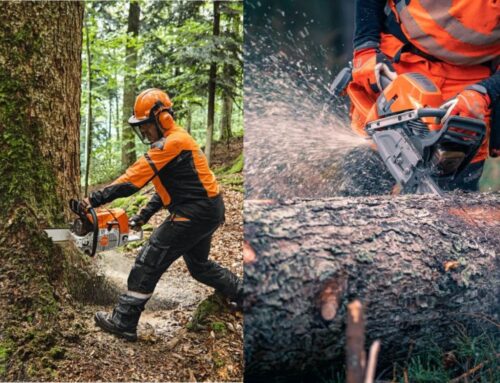
What Is the Right Lawnmower Cutting Height for Autumn?
Autumn is the season when your lawn quietly resets. Growth slows, temperatures soften, and moisture hangs in the air for longer. It’s exactly the right moment to rethink your lawn mower height so the grass goes into winter resilient rather than ragged. Get the cutting height right now and you’ll keep colour for longer, discourage moss, and give roots the protection they need for your lawn to bounce back strongly in spring.
In this guide, you’ll find the recommended lawn mower grass heights for autumn, why the figure changes for ride-on and robot machines, plus advice on the extra jobs that could make all the difference to your lawn’s health this autumn and beyond.
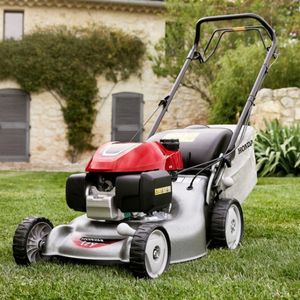 The Recommended Cutting Height for Autumn
The Recommended Cutting Height for Autumn
For most UK domestic lawns with cool-season grasses, the recommended lawn mower height in autumn is 3.5–4.5 cm (1.4–1.8 in). Think of it as a protective length: tall enough to shield the crown and soil from cold snaps and persistent rain, yet short enough to keep the sward tidy and dense. If you care for an ornamental lawn with a cylinder machine, avoid going too short at this time of year; as a sensible lower limit, 3.0 cm (1.2 in) is the floor for a well-kept fine lawn heading into colder weather.
If your lawn has been under stress—heavy foot traffic, shade, recent renovation, or patchy recovery after summer—err towards the top of the range. That single shift in the cutting height lawn mower setting helps the plant keep more leaf area, which in turn supports photosynthesis and root energy reserves when daylight and warmth are in shorter supply.
Why Ride-On and Robot Mowers Often Need a Different Setting
Not all machines treat grass the same way, which is why the best height for lawn mowers in autumn isn’t identical across the board. Ride-on mowers and robotic mowers cut differently from a conventional walk-behind, so it’s wise to fine-tune the number you dial in.
Riding Lawn Mower Cutting Height
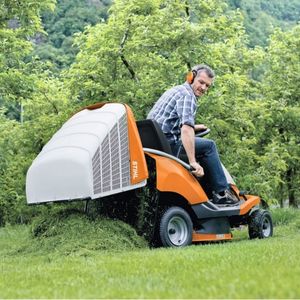 With a ride-on, you’re moving a wide, heavy cutting deck across ground that may already be soft after rain. The riding lawn mower cutting height should typically be a touch higher than you’d use on a smaller machine—4.0–5.0 cm (1.6–2.0 in) suits most general lawns in autumn. That extra length protects against scalping undulations, maintains airflow through the deck for cleaner collection in leafy weeks, and limits the volume of grass removed in a single pass. If you’ve been mowing at summer settings, make a small, deliberate change upwards. This is a classic case of adjusting cutting height lawn mower settings to match seasonal conditions rather than chasing the lowest cosmetic finish.
With a ride-on, you’re moving a wide, heavy cutting deck across ground that may already be soft after rain. The riding lawn mower cutting height should typically be a touch higher than you’d use on a smaller machine—4.0–5.0 cm (1.6–2.0 in) suits most general lawns in autumn. That extra length protects against scalping undulations, maintains airflow through the deck for cleaner collection in leafy weeks, and limits the volume of grass removed in a single pass. If you’ve been mowing at summer settings, make a small, deliberate change upwards. This is a classic case of adjusting cutting height lawn mower settings to match seasonal conditions rather than chasing the lowest cosmetic finish.
Special Notes for Ride-On Users
Begin each session on the higher side, have a short test run across any suspect dips, and then decide whether you can safely lower by a single step. Keep an eye on clippings and discharge: if the deck is clogging or the finish looks ragged, it’s often a sign that the deck is too low for the moisture level and leaf volume. Bumping the lawn mower height up restores airflow and a cleaner lift of the grass blade. If you’re vacuuming leaves with the collector, the same higher setting improves pick-up while protecting the sward.
Robot Lawn Mower Cutting Height
 A robot mower lives by a different rhythm. It trims little and often—sometimes daily—so it rarely shocks the turf. Even so, its cutting height in autumn should still come up a notch to 4.0–5.0 cm (1.6–2.0 in). The frequent schedule means grass stays short every day, which can expose crowns to cold and damp, especially in shaded areas. Raising the height on your robot lawn mower adjustable height dial (or in the app) leaves the grass longer so it can generate more energy through photosynthesis, even as temperatures begin to fall and sunlight fades. Because robots revisit the same ground repeatedly, a modest rise preserves quality and colour without sacrificing neatness.
A robot mower lives by a different rhythm. It trims little and often—sometimes daily—so it rarely shocks the turf. Even so, its cutting height in autumn should still come up a notch to 4.0–5.0 cm (1.6–2.0 in). The frequent schedule means grass stays short every day, which can expose crowns to cold and damp, especially in shaded areas. Raising the height on your robot lawn mower adjustable height dial (or in the app) leaves the grass longer so it can generate more energy through photosynthesis, even as temperatures begin to fall and sunlight fades. Because robots revisit the same ground repeatedly, a modest rise preserves quality and colour without sacrificing neatness.
Special Notes for Robot Owners
Robotic mowers excel when the schedule does the heavy lifting. In autumn, keep that schedule steady but nudge the robot lawn mower cutting height up. Changing by small increments avoids stressing the same patch of grass day after day. If your garden includes a mix of open lawn and shaded corners, use the machine’s zone controls—if available—to hold a higher setting where the grass struggles. App-based controls make adjusting lawn mower height almost effortless; a weekly review is enough to keep on top of things as conditions shift. As growth tails off late in the season, resist the temptation to ‘tidy’ by dropping the deck. Shorter grass in November is more vulnerable to frost discolouration and thinning, which is exactly what you’re trying to avoid.
How to Set Your Machine’s Cutting Height Without Guesswork
 Modern mowers make adjusting lawn mower height straightforward, but it’s still worth taking thirty seconds to confirm you’ve chosen the right notch. Lever positions can vary by brand, and the display might show millimetres, steps, or simple icons. If you can’t find the relevant information in the owner’s manual or on the manufacturer’s website, the most reliable approach is to park the mower on a hard, level surface, measure from ground to blade path, and use that as your reference.
Modern mowers make adjusting lawn mower height straightforward, but it’s still worth taking thirty seconds to confirm you’ve chosen the right notch. Lever positions can vary by brand, and the display might show millimetres, steps, or simple icons. If you can’t find the relevant information in the owner’s manual or on the manufacturer’s website, the most reliable approach is to park the mower on a hard, level surface, measure from ground to blade path, and use that as your reference.
If your machine quotes ranges rather than exact figures, aim for the midpoint that corresponds to 3.5–4.5 cm (1.4–1.8 in) for walk-behinds and 4.0–5.0 cm (1.6–2.0 in) for ride-ons and robots. That becomes your recommended lawn mower height benchmark for autumn. If you’ve recently overseeded, look to stay at the top of the range for a few weeks before moving down to the midpoint setting.
Why This Height Works in Autumn
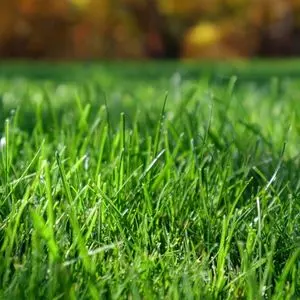 Cool-season grasses thrive when they have enough leaf to capture weak sunlight and enough height to insulate the crown. Autumn brings more shade, longer dew periods, and the odd cold night. A slightly taller sward helps moisture disperse above the soil line and buffers the grass against short frosts.
Cool-season grasses thrive when they have enough leaf to capture weak sunlight and enough height to insulate the crown. Autumn brings more shade, longer dew periods, and the odd cold night. A slightly taller sward helps moisture disperse above the soil line and buffers the grass against short frosts.
Keeping the best lawn mower cutting height for autumn helps your lawn remain even in colour, discourages thin patches where moss loves to settle, and protects roots from temperature swings. Meanwhile, you still get a crisp, managed look—this is not a ‘leave it long and hope for the best’ strategy, but a targeted setting that balances appearance and resilience.
Fine-Tuning for Lawn Type, Shade, and Soil
No two gardens are the same, so think of the figures above as a smart starting point. A high-traffic utility lawn that hosts pets and play benefits from the upper end of the range, because a touch more height cushions wear and keeps the surface forgiving. Shady lawns—under trees, beside tall buildings, or in the lee of fences—often look better and stay healthier when the lawn mower maximum cutting height you use in autumn is a notch higher than you’d set for sunny areas. That extra centimetre of grass helps support photosynthesis in low light.
 As always, try not to remove more than a third of the grass height in any single cut. If you’ve let the lawn grow on during bad weather, step down in two or three gentle cuts rather than one eager chop.
As always, try not to remove more than a third of the grass height in any single cut. If you’ve let the lawn grow on during bad weather, step down in two or three gentle cuts rather than one eager chop.
Other Considerations When Mowing in Autumn
Timing matters. Aim to mow when the grass is as dry as the day allows; long morning dews linger in autumn and wet blades don’t cut cleanly, heightening the risk of damage to your lawn. Where moss is creeping in, leave the sward slightly taller—an extra 1.0–2.0 cm (0.4–0.8 in) above the moss level helps the grass shade it out.
If you’ve had a flush of growth after rain, consider raising the deck a touch for one pass, then returning to your target setting a few days later. And keep an eye on the weather forecast; if a spell of heavy rain is coming, mowing a day earlier at your normal recommended lawn mower height avoids tackling saturated ground later.
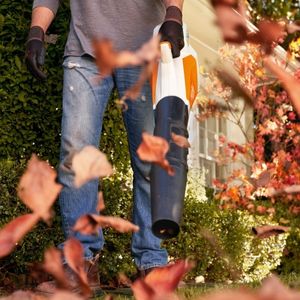 A Quick Summary of Other Autumn Lawncare Tasks
A Quick Summary of Other Autumn Lawncare Tasks
Autumn is the perfect time for supportive work that multiplies the benefit of a well-chosen cutting height. Aeration relieves compaction and helps rain reach the grass’ roots rather than sitting on the surface; it’s particularly effective on heavy or well-used lawns. If you’ve scarified or raked out thatch recently, over-seeding ties the renovation together and thickens the sward before winter. Low-nitrogen autumn feed provides balanced nutrition without pushing soft top growth.
Regular leaf clearance is important too, as it helps light reach the grass, reducing the risk of disease and preventing slimy mats weakening the lawn. All of these jobs are modest on their own, but combined with the best lawn mower height for the season, they set your lawn up for a confident start to the following spring.
Ready to Get the Right Machine at the Right Setting?
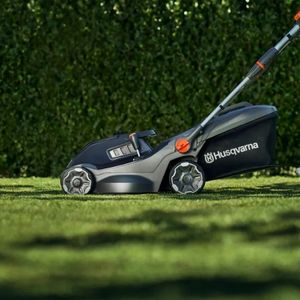 If you’re looking for a new lawnmower this autumn, you’re in exactly the right place to find one. From precise walk-behind mowers with intuitive levers to ride-ons with effortless deck controls and class-leading robots with app-based adjustments, you’ll find the UK’s best lawnmowers for sale here.
If you’re looking for a new lawnmower this autumn, you’re in exactly the right place to find one. From precise walk-behind mowers with intuitive levers to ride-ons with effortless deck controls and class-leading robots with app-based adjustments, you’ll find the UK’s best lawnmowers for sale here.

